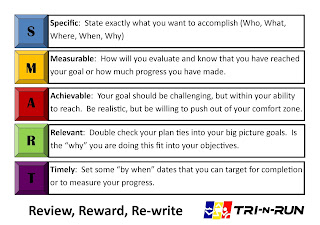So it’s warming up in Vancouver and a few months have past since we decided on our new year’s resolutions for 2016. How are you doing on yours? Maybe you’re doing great (congratulations!), or maybe you could use a little extra motivation to stay or get back on track. This week, I’d like to discuss some goal-setting tactics to help you make the most of those resolutions or other goals that you are working toward.
I’ve included some further discussion on goal-setting later on in this post, but first I’d like to talk about a few ways to stay accountable and motivated in reaching for your goals.
1. Write it down. Make a contract with yourself. Write down your goal(s) and sign in. Post this paper somewhere you’ll see it each day. If you’re feeling creative, decorate it with pictures or magazine clippings that are relevant to your goals.
2. Tell somebody about it. Tell a good friend or spouse or parent or co-worker or anyone about your goal. Reach out to this person (or people!) when you’re not feeling motivated. If somebody else knows how important this goal is to you, they can give you a pep talk when you need it!
3. Make a goal-buddy. Maybe another person near and dear to you is looking to achieve the same goal. Now you can look forward to seeing that person and spending some time together working towards a mutual goal. Again, this is great for the pep talks when you’re needing them as well.
4. Check out photos/videos/articles related to your goals. Sometimes it helps to have a pinterest board or follow an instagram account with people doing what you’re looking to achieve. For example, maybe you’re really interested in getting into cycling. Look for more information about cycling, or find some videos for beginners if you’re new to cycling. You can learn some tips and tricks which can help you past sticking points. These can also serve as inspiration or motivation on the days you’re just not feeling it (hey it happens to the best of us!)
5. Break your goal down into smaller goals. Maybe the idea of running a 10km race feels overwhelming. Think about smaller goals that can help you along your way. Maybe your first goal is to complete 3 shorter training runs in one week. Or, break your runs down into run-walk intervals so you have some time to slow down and catch your breath. By creating multiple smaller goals, you give yourself a sense of achievement after you complete each of these goals, rather than creating potential frustration if you do not meet your big picture or overall goal of running 10km right away.
6. Address troubles directly and quickly. If your goal is to run 10km, and you happen to fall victim to a sprained ankle, that is going to be frustrating. Instead of pushing through this, go see your physio or your massage therapist and have them take a look at it. The quicker you recover or find a solution, the quicker you can get back to working on your goals.
Next, let’s look at actually setting goals. Many use the mnemonic “SMART.”
1. S is for specific: Your goals need to be specific. Goals can start off as “I want to eat better,” but you’ll need to make some decisions as to what better means for you. For example, maybe eating better means that you want to add more vegetables to your daily diet. In this case, a more specific goal could be: “I want to add two more servings of vegetables to my diet each day.”
2. M is for measurable: We need to find a way to measure this. If we continue with the example above, we might measure this goal by creating a food diary, or using a food tracking app to count the servings of vegetables you are eating each day.
3. A is for attainable or adjustable: You should keep your goals within reason. Your goal cannot be “I want to fly like a bird” because you are likely not going to sprout the wings to be able to do this. Set your goals so they are challenging but so difficult that they are unreachable. Another good way to think of this is to keep your goals adjustable. This means that you have some wiggle room. For example, if you are training to run your very first 5km race, maybe you have set your goal to complete 3 training runs in each week leading up to your race. You will need to have some leeway if you fall ill and are unable to breathe properly to do those runs. Alternatively, maybe you are finding you are achieving your goal of 3 runs each week and finding it easier than you thought! In this case, adjusting your goal to keep challenging you is a great way to stay motivated. Maybe you decide to add a 4th day of sprints to your 3 more slowly-paced training runs.
4. R is for relevant: Any stepping stones or sub-goals need to be related to your overall or big picture goal. For example, if your goal is to run a 5km race, you wouldn’t necessarily add a swimming goal in pursuit or your running goal.
5. T is for time-bound: You should add a deadline or time frame to your goal. This can help keep you on track. For example, if you are training for that 5km race, sign up for that race in advance! This will give you a very specific deadline of when and how you’ll want to plan your training runs.
InSync Physiotherapy is a multi-award winning health clinic helping you in Sports Injuries, Physiotherapy, Exercise Rehabilitation, Massage Therapy, Acupuncture & IMS.


